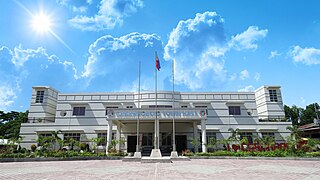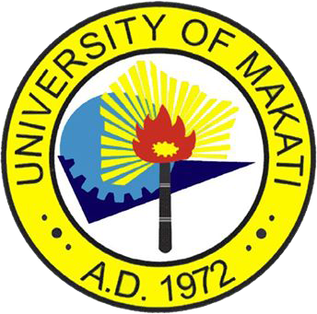Related Research Articles

Divilacan, officially the Municipality of Divilacan, is a 2nd class municipality in the province of Isabela, Philippines. According to the 2020 census, it has a population of 5,827 people.

Gamu, officially the Municipality of Gamu, is a 4th class municipality in the province of Isabela, Philippines. According to the 2020 census, it has a population of 30,655 people.

Luna, officially the Municipality of Luna, is a 5th class municipality in the province of Isabela, Philippines. According to the 2020 census, it has a population of 20,697 people.

Reina Mercedes, officially the Municipality of Reina Mercedes, is a 4th class municipality in the province of Isabela, Philippines. According to the 2020 census, it has a population of 27,900 people.

San Agustin, officially the Municipality of San Agustin, is a 3rd class municipality in the province of Isabela, Philippines. According to the 2020 census, it has a population of 22,096 people.

San Guillermo, officially the Municipality of San Guillermo, is a 4th class municipality in the province of Isabela, Philippines. According to the 2020 census, it has a population of 20,915 people.

San Mateo , officially the Municipality of San Mateo, is a 1st class municipality in the province of Isabela, Philippines. According to the 2020 census, it has a population of 66,663 people.

Santo Tomas, officially the Municipality of Santo Tomas, is a 4th class municipality in the province of Isabela, Philippines. According to the 2020 census, it has a population of 24,528 people.

Cabarroguis, officially the Municipality of Cabarroguis, is a 3rd class municipality and capital of the province of Quirino, Philippines. According to the 2020 census, it has a population of 33,533 people.

Mawab, officially the Municipality of Mawab, is a 3rd class municipality in the province of Davao de Oro, Philippines. According to the 2020 census, it has a population of 39,631 people, making it the least populated municipality in the province.

Amaya School of Home Industries is a public high school located at Sahud-Ulan, Tanza, Cavite, Philippines. The school was established by virtue of Republic Act No. 3987 which was approved on June 18, 1964.

The University of Makati, commonly referred to as UMak, is a public, non-sectarian higher education institution in Taguig, Metro Manila. It is managed and operated, administered by the City of Makati, which is subject to ownership dispute with the City of Taguig. It was founded in 1972 by the Makati government as the Makati Polytechnic Community College by virtue of Municipal Resolution No. 242 Ordinance No. 64.
General Pio del Pilar National High School(abbreviated as: GPDPNHS, filipino: Mataas na Paaralang Pambansa ng Heneral Pio del Pilar, informal: Pio) is a Public Secondary School located in Osias St., Barangay Poblacion, Makati. It follows the newly-enforced MATATAG curriculum set by the Department of Education for its Grade 7 students while offering the K-12 Curriculum for Grade 8 - 10.
Daniel R. Aguinaldo National High School is a public secondary school in the Davao Region of the Philippines. It is the largest high school in Davao City. Its School ID number is 304359. It has been in business since 1967.

St. Peter's College of Toril also referred to by its acronym SPCT is a private, Catholic coeducational basic and higher education institution administered by the Sisters of the Presentation of Mary in Toril, Davao City. It was founded by the Society of Foreign Missions (P.M.E.) on July 1, 1948.

Juan R. Liwag Memorial High School (abbreviated as JRLMHS; Filipino: Pang-alaalang Mataas na Paaralang Pambansa ng Juan R. Liwag) is a secondary public school in Barangay Bayanihan, Gapan, Nueva Ecija, Philippines. It was formerly known as Nueva Ecija South High School. It was established in 1945 and made into a national high school by virtue of BP Blg. 143 on 8 February 1982. The current principal of the main campus is Cristina S. Parungao, Principal IV.
Information Communications Technology is usually included in the Home Economics and Livelihood Education program in grade school and taught through the Technology and Home Economics program in high school. The recent status of ICT education in the Philippines, along with other Southeast Asian countries, was surveyed by the Southeast Asian Ministers of Education Organization (SEAMEO) in 2011. Using the UNESCO model of ICT Development in Education, the countries were ranked as Emerging, Applying, Infusing or Transforming. The Philippines were ranked at the Infusing stage of integrating ICT in education, indicating that the country has integrated ICT into existing teaching, learning and administrative practices and policies. This includes components such as a national vision of ICT in education, national ICT plans and policies, complementary national ICT and education policies, professional development for teachers and school leaders, community or partnership and teaching and learning pedagogies. A 2012 study reported that public high schools in Metro Manila had a computer to student ratio of 1:63. While 88 percent of schools have internet connections, half of the students claimed not to be using it.
Marydale "Maymay" Entrata is a Filipino actress, singer, model and television host. Having achieved mainstream success across television, music and fashion, she came to prominence after winning the reality show Pinoy Big Brother: Lucky 7. She is the first Filipina to walk at the Arab Fashion Week. Her accolades include a FAMAS Award, an Awit Award, two PMPC Star Awards for Music and a Box Office Entertainment Awards, in addition to a nomination for an MTV Europe Music Award.
Edward John Abellera Barber is a Filipino-British actor and host who came to prominence in 2016, after joining the reality television series Pinoy Big Brother: Lucky 7, where he placed fourth.

Joji Ilagan Career Center Foundation, Inc. is a conglomerate of schools under the JIB Group of Companies, based in Davao City, Philippines. It was founded by its chairwoman, Joji Ilagan Bian, after whom the school is named.
References
- ↑ Neptune St., Crossing Bayabas, Toril, Davao City
- 1 2 "Republic Act No. 8388 | GOVPH". Official Gazette of the Republic of the Philippines. Retrieved 2018-02-16.
- ↑ [External links 1]
- ↑ [External links 2]
- ↑ [External links 3]
- ↑ [External links 4]
- ↑ [External links 5]
- ↑ "Doña Carmen Denia National High School". www.facebook.com. Retrieved 2023-02-02.
- 1 2 3 4 5 6 7 8 9 10 Fuggan, M., Tinio, M., Bayocboc, W., Cruz, B., Lozada, G., Gamez, M. G., Digao, E., Gasta, M., Catipay, M., Calamba, D., Serafica, M., Bacalso, K., Simbajon, L., Justiniane, E., Bajade, E. ''Student Handbook'' (2017, sixth edition). Crossing Bayabas, Toril, Davao City, Philippines.
- ↑ "Archived copy" (PDF). Archived from the original (PDF) on 2018-01-27. Retrieved 2018-02-16.
{{cite web}}: CS1 maint: archived copy as title (link) - ↑ "Barangay Crossing Bayabas, Davao City". dvobrgy.usep.edu.ph. Archived from the original on 2018-09-22. Retrieved 2018-09-23.
- ↑ "Google Maps" . Retrieved 2022-05-02.
- ↑ "Google Maps". Google Maps. Retrieved 2018-02-16.
- ↑ TODAY, DAVAO (2007-12-05). "Datu Bago: Villain or Hero?". Davao Today. Retrieved 2023-02-02.
- ↑ "School Congestion in the Philippines: A Breakthrough Solution". 5 April 2017.
- ↑ "Barangay Crossing Bayabas, Davao City". Archived from the original on 2018-04-15. Retrieved 2018-02-16.
- ↑ "Crossing Bayabas Barangay Council". Archived from the original on 2018-01-15. Retrieved 2018-02-16.
- ↑ "Republic Act No. 8388 - GOVPH". officialgazette.gov.ph.
- ↑ Sunday High School Program
- ↑ "Regional Memo | Department of Education". www.deped.gov.ph. Archived from the original on 2018-02-11. Retrieved 2018-02-16.
- ↑ "Archived copy" (PDF). Archived from the original (PDF) on 2018-04-10. Retrieved 2018-02-16.
{{cite web}}: CS1 maint: archived copy as title (link) - ↑ "R.a. 9003".
- ↑ https://emb.gov.ph/wp-content/uploads/2015/09/RA-9003.pdf [ bare URL PDF ]
- ↑ "Technology and Livelihood Education (TLE) and Technical-Vocational-Livelihood (TVL) Track | Department of Education". www.deped.gov.ph. Archived from the original on 2018-02-11. Retrieved 2018-02-16.
- ↑ "DepEd provides coping mechanisms for learners during hostilities". Eagle News. 2016-08-23. Retrieved 2018-09-26.
- ↑ "REPUBLIC ACT NO. 9003" (PDF). Republic Act No. 9003: 44.
- ↑ "DO 40, s. 2012 – DepEd Child Protection Policy | Department of Education". www.deped.gov.ph. Retrieved 2018-09-23.
- ↑ "DO 55, s. 2013 – Implementing Rules and Regulations (IRR) of Republic Act (RA) No. 10627 Otherwise Known as the Anti-Bullying Act of 2013 | Department of Education". www.deped.gov.ph. Retrieved 2018-09-23.
- ↑ "DO 47, s. 2014 – Constitution and By-Laws of the Supreme Pupil Government and Supreme Student Government in Elementary and Secondary Schools | Department of Education". www.deped.gov.ph. Retrieved 2018-09-23.
- ↑ "Constitution and By-Laws of the Supreme Pupil Government and Supreme Student Government in Elementary and Secondary Schools" (PDF). DepEd Order No. 47, S. 2014: 7. 1 December 2014. Archived from the original (PDF) on 24 October 2018. Retrieved 25 September 2018– via DepEd Calabarzon.
- ↑ Entrata, Maymay (March 16, 2017). "Loyola Elem. School, Crossing Bayabas National High School, Bugo National High School, and MUST! Mag kita'2 ta ninyo puhon. Love youu! ❤️". Twitter. Retrieved 2023-02-02.
- ↑ "Crossing Bayabas National High School - CBNHS Alumni Association - Maymay Entrata of Pinoy Big Brother Abs-Cbn wearing CBNHS uniform... Congrats Maymay Entrata... 😊 | Facebook". www.facebook.com. Retrieved 2023-02-02.
- ↑ "#Maymay #Entrata (Mary Dale Entrata) of #PBB was once a student of Crossing Bayabas National High School, Toril Davao City before she transferred to Cagayan de Oro City. Kaway-kaway sa naging kaklase ni... - Crossing Bayabas National High School - CBNHS Alumni Association". www.facebook.com. Retrieved 2023-02-02.
- ↑ "eto na po request nyo guys 😆😆 "MAYMAY ENTRATA, PROUD AND ORIGINALLY FROM CLUSTER 4, TORIL DISTRICT, DAVAO CITY" #cluster4". Facebook (in Cebuano). April 24, 2020. Retrieved 2023-02-02.
- ↑ "Congratulations Jona Marie Soquite for winning the "1st The Voice Teens Philippines" as Grand Champion. Your Crossing Bayabas National High School Family is proud of you! #DAVAOEAGLES #TalentWithAheart #PHILIPPINEEAGLE #CrossingBayabasNHSisProudofYou! Jona Soquite Official". Facebook. July 31, 2017. Retrieved 2023-02-02.
- ↑ "Crossing Bayabas National High School - CBNHS Alumni Association - Sa lahat po ng mga Alumni ng Crossing Bayabas National High School, please support our very own Jona Soquite to be the first grand winner of The Voice Teens. Taga CBNHS, taga Lubogan, taga Toril, proud Dabawenyo. text VOICE JONA and send to 2366. | Facebook". www.facebook.com. Retrieved 2023-02-02.
- ↑ "Smile..😊 Like and follow Jona Marie Soquite on Facebook for latest and more updates! #JonaSoquite #JonaSoquiteFacebookUpdate". Twitter. October 16, 2019. Retrieved 2023-02-02.
- ↑ Adrales, Jonathan (June 11, 2019). "When one of your students is the grand champion of The Voice Teens Philippines! Jona Marie Soquite 💕". Facebook. Retrieved February 3, 2023.
- ↑ "I dont have a solo picture with my certificate so ito nlng😂Thank you Lord for this great achievement.A good start for my student life.I will keep it up and promise to do more♥ Like and follow Jona Marie Soquite on Facebook for latest and moreupdates! #JonaSoquiteFacebookUpdate". Twitter. August 15, 2019. Retrieved 2023-02-02.